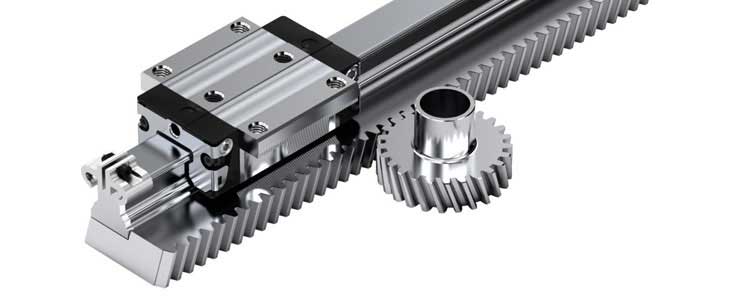 If you’re looking for information on electric actuators, then check out the latest from motioncontroltips.com Design World sister site linearmotiontips.com. This website details the specification and use of various linear-motion guides and drives — including mechanical rotary-to-linear converters such as lead screws and ballscrews — as well as actuators and even fully integrated stages, gantries, and Cartesian robots.
If you’re looking for information on electric actuators, then check out the latest from motioncontroltips.com Design World sister site linearmotiontips.com. This website details the specification and use of various linear-motion guides and drives — including mechanical rotary-to-linear converters such as lead screws and ballscrews — as well as actuators and even fully integrated stages, gantries, and Cartesian robots.
The following is a sampling of features we’ve posted there over the last few weeks on linear applications.
Feature: Rail and rack-and-pinion sets satisfy machine demands
Here’s a nice feature from my colleague Danielle Collins on what profiled linear guides are and where they go. More specifically, in this feature she explains drives that forgo the typical belt or ballscrew for rack-and-pinion sets to get rigid and accurate motion. She also details special parameters to meet when using these for long travel and high-force machine axes. 
Feature: How to calculate motor drive torque for ball screws
 In this linearmotiontips.com piece, Danielle details how intermittent motor torque is that considered acceptable for brief intervals by the motor manufacturer.
In this linearmotiontips.com piece, Danielle details how intermittent motor torque is that considered acceptable for brief intervals by the motor manufacturer.
This is usually of concern when an axis is accelerating and temporarily drawing more torque.
In contrast, a motor’s continuous torque is the root mean square of all the torques the motor must deliver for a range of typical application tasks — including torque during acceleration, torque during constant speed, and torque during deceleration …
Engineering summary: Basics of rigid-chain actuators
This is a linearmotiontips.com piece I had the pleasure of assembling for a recent Design World special. (Subscribe to the digital issue of Design World here.) In short, this piece details how rigid-chain actuators work by pairing a drive (usually an electric motor) with a specialized form of chain. Common applications are vertical lifts of all shapes and sizes, as well as setups that need a linear actuator that pushes and pulls and then retracts into a tight coiled space.
Quick technical primer: A servo system glossary for the mechanical engineer
Even if an engineer never needs to setup and tune a servo system, it’s still helpful to understand terminology that describes servo performance. This post is a nice lineup of some of these basic definitions and links to references that go into more depth.
In addition to these and other technical pieces, you’ll also find the latest product announcements on linearmotiontips.com as well. Click on the headers for more information.
IMS-A integrated linear measuring system from Rexroth is inductive and precise
Whether in machining operations, 3D printing or electronic handling, ever-greater accuracy and availability are essential. The new Rexroth IMS-A linear measuring system — integrated in linear guides — is more precise than alternatives …
New HRS Series industrial electric actuators from Hayward Flow Control
Hayward Flow Control now sells HRS Series Quarter Turn Electric Actuators.
Dynamic linear stages from Aerotech use piezo-elements for nanopositioning
Aerotech’s QNP linear piezo nanopositioning stages provide the benefits of both a stage and actuator in one stiff package.
Festo streamlines selection and commissioning of electrical linear axes
The Optimized Motion Series of packaged linear and rotary electrical axes solutions, introduced by Festo, helps lower OEM overhead by speeding up specification, assembly, and commissioning of axes.
Tolomatic belt-drive actuator handles harsh environments
Tolomatic’s family of MXB electric belt-drive actuators includes a new solid bearing load-carrying design ideal for harsh environments. The trapezoidal solid bearing is a rigid, long-lasting bearing system.
Miniature voice coil actuators
H2W Technologies offers miniature versions of both moving coil and moving magnet voice coil actuators. Plus the company offers custom designed solutions to meet application specifications.












Leave a Reply
You must be logged in to post a comment.